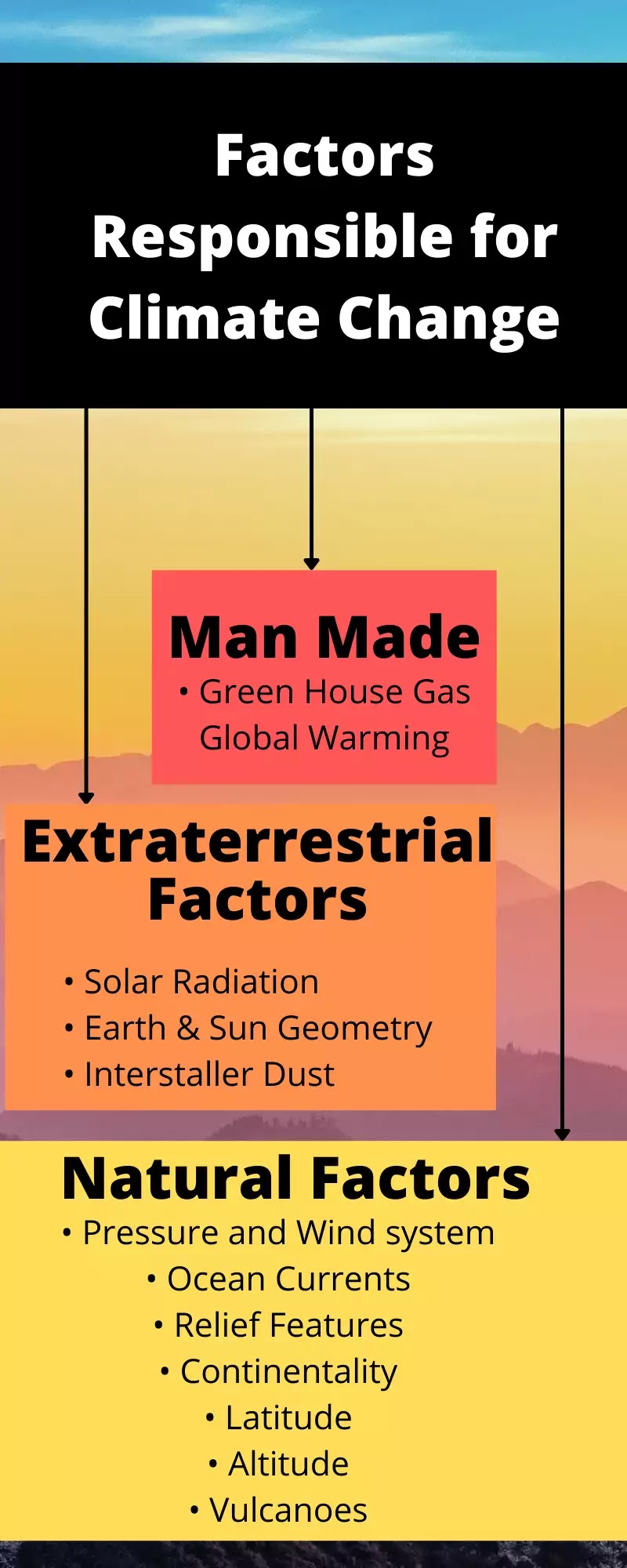Introduction:
- Weather refers to the state of the atmosphere over an area at any point of time. The weather conditions fluctuate very often even within a day.
- There is some common pattern over a few weeks or months, i.e. days are cool or hot, windy or calm, cloudy or bright, and wet or dry.
- On the basis of the generalized monthly atmospheric conditions, the year is divided into seasons such as winter, summer or rainy seasons, which are mainly caused by the inclination of the earth’s axis and the revolution of the earth around the sun, are known as Seasons.
- Climate refers to the sum total of weather conditions and variations over a large area for a long period of time (more than thirty years). For Example: Rajasthan experiences hot and arid climate, Kerala has tropical rainy climate.
The elements of weather and climate are the same. These elements are -
- Temperature
- Atmospheric pressure
- Wind
- Humidity and
- Precipitation
Weather | Climate |
Weather is the study of atmospheric conditions for short duration of a limited area. | Climate is the study of the average weather conditions observed over a long period of time for a larger area. |
The weather changes very often. | It is more or less permanent. |
It is experienced over small areas of a country. | It is experienced over large area of the continent. |
Weather is influenced by anyone of its predominant elements i.e., temperature or humidity. | Climate is the collective effect of all its elements. |
A place can experience different types of weather conditions in a year. | A place can experience only one type of climate. |
- The climate of India is described as the ‘monsoon’ type. In Asia, this type of climate is found mainly in the south and the southeast.
- There are variations not only in the form and types of precipitation but also in its amount and the seasonal distribution.
- While precipitation is mostly in the form of snowfall in the upper parts of Himalayas, it rains over the rest of the country.
- The annual precipitation varies from over 400 cm in Meghalaya to less than 10 cm in Ladakh and western Rajasthan.
- Most parts of the country receive rainfall from June to September.
- But some parts like the Tamil Nadu coast gets a large portion of its rain during October and November.
- The coastal areas experience less contrasts in temperature conditions.
- Seasonal contrasts are more in the interior of the country.
- There is decrease in rainfall generally from east to west in the Northern Plains.
- These variations have given rise to variety in lives of people – in terms of the food they eat, the clothes they wear and also the kind of houses they live in.
(3) advancing monsoon season or rainy season (June to September.) and.
(4) retreating monsoon season (October to November.)
Factors Affecting Climate:
Different regions of the world have differences in temperature, humidity and precipitation. There are several major controls of the climate of any place. They are:
- Latitude: The places near the equator are warmer than the places which are far away from it.
- Altitude: For a vertical rise of 165 metres there is an average decrease in temperature at the rate of 1°C. Thus, the temperature decreases with increase in height.
- Pressure and Wind system: The Earth's average pressure patterns and resulting winds influence climate patterns by: advecting temperature and moisture.
- Distance from the sea (continentality): Due to this moderating effect of the sea, places near the coast have low range of temperature and high humidity. The places in the interior of the continent do not experience moderating effect of the sea.
- Ocean Currents: Ocean currents are large movements of water usually from a place of warm temperature to one of cooler temperature or vice-versa.
- Relief features: The on-shore moisture laden winds are forced to rise after striking against the mountain; and give heavy rainfall on the windward side.
- Cloud Cover: In areas generally of cloudless sky as in deserts, temperature even under shade are very high because of the hot day time sunshine. At night this heat radiates back from the ground very rapidly. It results in a large diurnal range in temperature. On the other hand under cloudy sky and heavy rainfall at Thiruvananthapuram the range of temperature is very small.
- The Nature of the Soil and Vegetation Cover: Stony or sandy soils are good conductor of heat while black clay soils absorb the heat of the sun’s rays quickly. The bare surface reradiates the heat easily. The deserts are hot in the day and cold in the night. The forest areas have lower range of temperature throughout the year in contrast to non-forested areas.
Climatic Classification of Wladimir Koeppen (1846-1940):
It is most widely accepted system of climatic classification. It is based on monthly atmospheric conditions, which is depends on temperature, precipitation and their seasonal characteristics. The relationship of climate with the vegetation is also included with it. the world has been divided into five climatic groups and they are further sub-divided into 13 climatic types. They are -
Climate Group | Climate Type |
(A) Tropical climates (hot all season) | Af (i) Tropical rain forest Aw (ii) Savanna Climate Am (iii) Monsoon Climate |
(B) Dry climates | Bw (iv) Desert Climate Bs (v) Steppe Climate |
(C) Warm temperate rainy or Middle latitude rainy climates (mild winters) | Cs (vi) Mediterranean Climate Cw (vii) China Type Climate Cf (viii)West European Climate |
(D) Humid Middle latitude climates (severe winters) | Dw (ix) Taiga Climate Df (x) Cool East-coast Climate (xi) The Continental Climate |
(E) Polar climates | Et (xii) Tundra Climate Ef (xiii) Ice-cap Climate |



Post a Comment
Post a Comment
Thanks...keep in touch 🤟